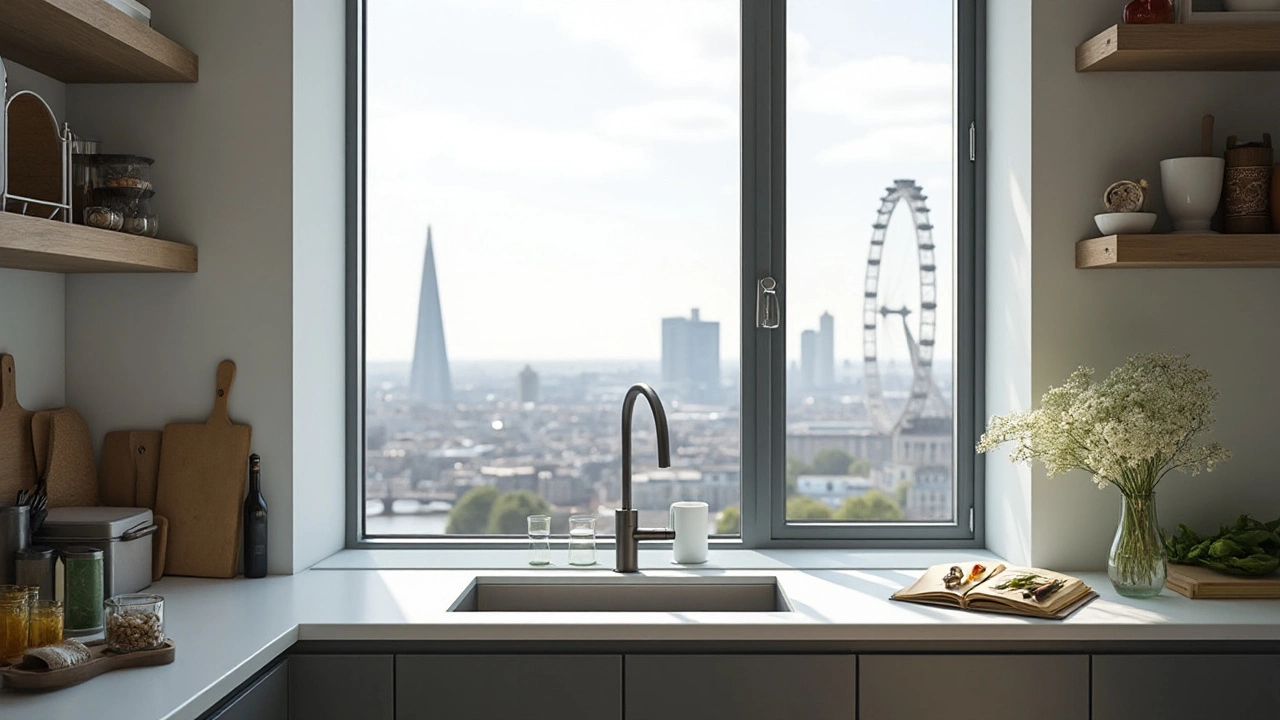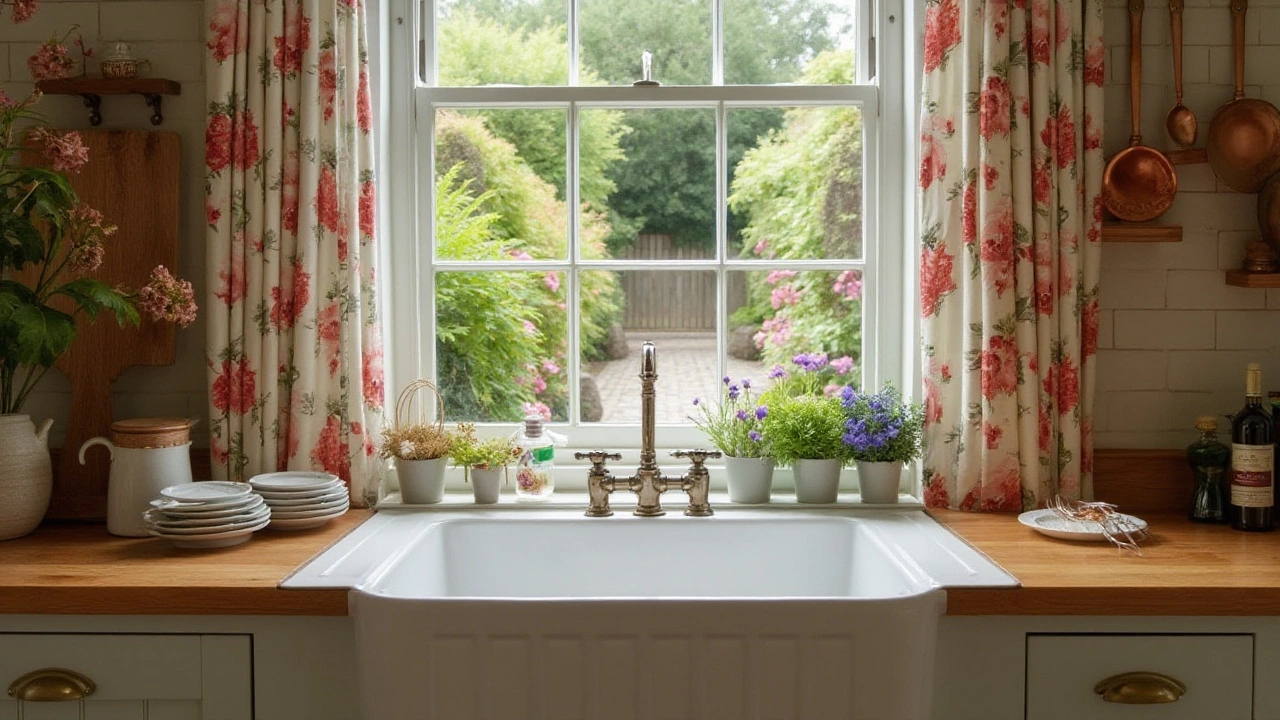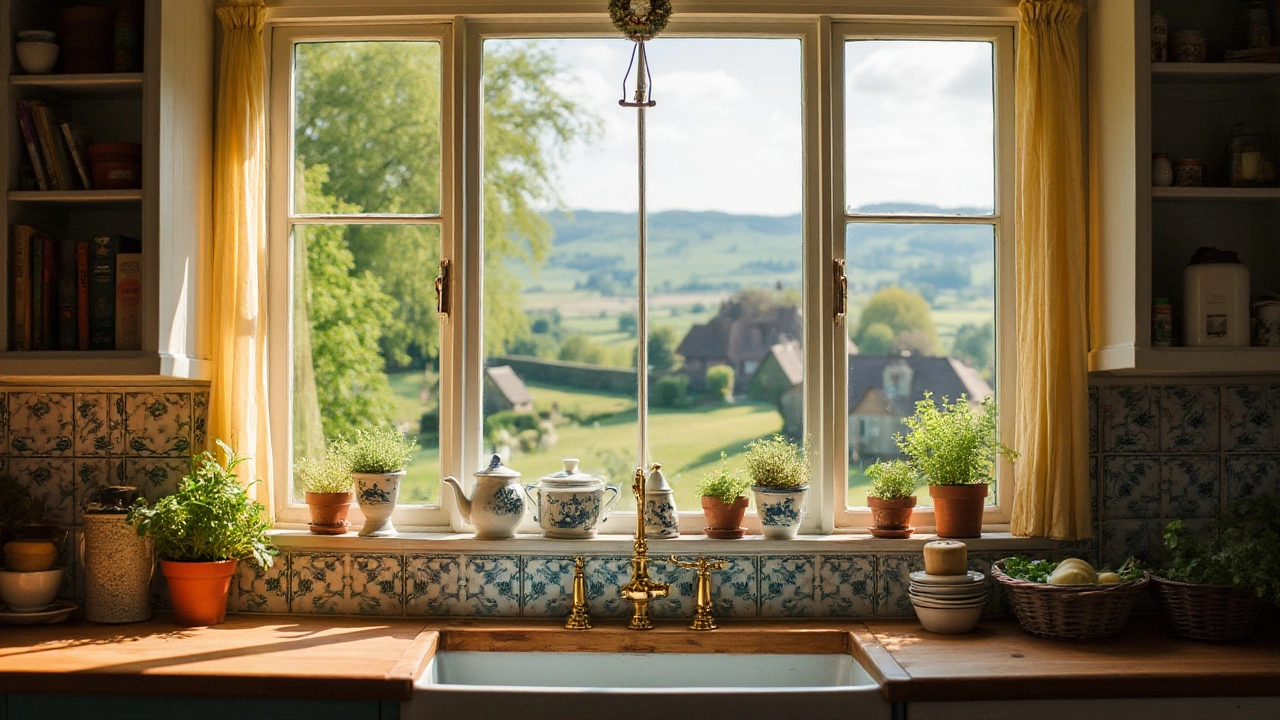In many homes, the kitchen sink finds its place nestled below a window, a design element so common that it's easy to overlook. Yet, this strategic positioning offers more than just a pretty view. It's a choice steeped in tradition and purpose, one that enhances functionality and comfort in the bustling heart of the home.
The tradition of placing kitchen sinks in front of windows dates back decades, serving not only for convenience but also as a clever means of making chores less mundane. Elements like natural light transform the kitchen from merely functional to inviting, improving the mood and even the productivity of those who spend time there.
Moreover, this arrangement invites a flood of natural light and fresh air into an area that can often feel cramped and stale. Imagine washing dishes under a gentle glow or letting a cool breeze wash away the steam from a pot of boiling cooking. It's details like these that transform routine activities into moments of serenity and reflection.
- Historical Significance
- Natural Light Benefits
- Ventilation and Fresh Air
- Aesthetic Appeal
- Practical Tips for Design
Historical Significance
The placement of kitchen sinks in front of windows is a hallmark of home design with roots tracing back to the early 20th century. As indoor plumbing became a staple in households, the need for efficient and pleasant workspaces within the home emerged. With this change, architectural design began to prioritize practicality alongside aesthetics. By the 1930s, builders routinely installed kitchen sinks beneath windows, not just out of necessity but also to afford the homemaker a view of the outdoors. This decision was indicative of the period's shift towards more considerate design, aiming to improve daily living experiences.
In those earlier times, homes were blessed with fewer appliances and more manual labor. Consider that during such times, a homemaker could easily spend several hours a day tied to chores like washing dishes. The window placement allowed an escape from the monotony of scrubbing and polishing, providing a scenic distraction. This tradition persisted through subsequent decades, further ingraining itself into the design ethos of kitchens. It began as a utilitarian choice, yet it quickly evolved into a design standard, providing both visual relief and functional benefits.
Historically, natural light was not just a luxury but a necessity. Electricity was not as widespread and reliable as today, and sunlight was vital for tasks that required clear visibility. Locating sinks under a window maximized the availability of daylight, significantly reducing the need for artificial lights during daytime hours. This setup naturally aligns with human circadian rhythms, supporting the body's internal clock by using natural cues for time regulation and activity pacing.
"The design choice of situating sinks under windows was less about aesthetics and more about making the best of natural light," observed architectural historian John D. Treglowan.
Let's also not forget about ventilation, an essential factor that played into the decision of placing kitchen sinks by the window. Prior to modern overhead fans and advanced HVAC systems, the window served as the primary means of ensuring airflow and managing cooking odors. A simple swing or slide of the window would allow fresh air to replace the humid, warm air generated by kitchen activities, maintaining a comfortable environment. In the absence of mechanical ventilation, the natural airflow was a cost-effective and energy-saving solution that leveraged readily available resources to enhance kitchen design.
This arrangement not only reflects the technology and constraints of past decades but illustrates the resourcefulness of homeowners and designers striving to create harmonious living spaces. By aligning practicality with beauty, they set a design precedent that continues to dominate kitchen design choices today, alongside evolving styles and innovations. As such, the historical significance of these kitchen sinks is etched into the culture of modern home design, much like an heirloom passed from generation to generation: a simple solution, lasting because it makes so much sense.
Natural Light Benefits
Imagine stepping into a kitchen where the warm glow of the morning sun greets you, setting the tone for the day ahead. This is one of the key reasons why placing a kitchen sink in front of a window is a much-loved design feature. The presence of natural light can transform the kitchen experience from routine to rejuvenating. Studies have shown that exposure to natural sunlight positively impacts mood and productivity, making those daily chores at the sink a little less mundane. It’s not just about aesthetics; it's about well-being.
The kitchen is often considered the heart of the home, where family and friends gather, meals are prepared, and memories are made. Adequate lighting is crucial in these spaces—not only for practical reasons, like ensuring a well-lit countertop for chopping and cooking, but also for creating an inviting atmosphere. Bright, natural light can also help in reducing eye strain and enhancing visibility, making tasks like washing delicate glassware or checking the quality of produce easier and more pleasant.
The Health Benefits
Natural light’s benefits extend beyond mere convenience. Exposure to sunlight helps regulate circadian rhythms, the body’s natural clock, which can improve sleep patterns, energy levels, and hormonal balance. Additionally, sunlight is a natural source of Vitamin D, essential for bone health and immune function. For those who find themselves spending significant time in the kitchen, these health advantages can be subtle yet profound. An oft-overlooked benefit of sunlight in the kitchen is its ability to foster cleanliness. Natural sunlight naturally deters the growth of mold and bacteria, a boon in any food-preparation area.
"Natural light in a kitchen is like a breath of fresh air, invigorating the spirit and enhancing the whole cooking experience,” notes interior designer Emma Jacobs.
Designers and architects frequently emphasize the link between natural lighting and open spaces. By positioning the sink by a window, kitchens seem larger and ceilings higher, which contributes to an airy, open feel. Additionally, the frequent use of water around the sink creates natural humidity, which can be elegantly balanced by a window’s capacity to let light and air flow in, maintaining an optimal indoor atmosphere. Having this setup means you can enjoy the sights and sounds of nature as you go about your tasks, injecting calm into what could otherwise be a place of hustle and bustle.

Ventilation and Fresh Air
When designing a kitchen, one of the primary considerations is how to effectively manage airflow and ensure the space feels fresh and inviting. Placing a kitchen sink in front of a window plays a pivotal role in achieving this. The location under the window allows for easy access to fresh air with a simple flick of the opening mechanism. This functionality is crucial, especially during cooking or after meal preparation, when the kitchen can quickly become a hotspot of steam, odors, and heat. Fresh air circulation helps dispel unwanted smells and reduces the build-up of condensation, which can prevent mold and other issues. This strategic placement capitalizes on natural ventilation, offering a practical solution without the added cost of excessive mechanical ventilation systems.
Furthermore, the presence of a window allows natural breezes to enter, providing a cooling effect during hot days when kitchen activities contribute to rising temperatures. This aspect of kitchen design enhances energy efficiency by minimizing reliance on electric fans or air conditioning. Moreover, allowing natural air exchange improves indoor air quality, reducing pollutants and potential allergens. In a bustling home environment, maintaining this fresh air cycle effortlessly blends well with a sustainable and healthy living ethos. It's worth noting that, according to the Residential Air Flow Studies, natural ventilation can significantly reduce indoor air pollution levels, offering cleaner air with fewer particles per million.
Besides practical benefits, there's an invaluable psychological aspect to having a kitchen sink by the window. Opening the window provides a direct line to the outside world, which can be refreshing and rejuvenating, offering brief reprieves from the bustling indoor life. It's an opportunity to pause, take in the natural surroundings, and momentarily escape to the rhythm of nature. This mental breather often translates to an improved mood and mental well-being, adding to the seemingly mundane chore of dishwashing. A connection to the outside environment fosters a seamless blend between indoor comfort and outdoor vitality, a design intention that taps into our natural instincts.
"Creating a seamless indoor-outdoor interaction is one of the fundamental aspects of a harmonious home," says renowned interior designer Emily Henderson. "A window over the kitchen sink invites fresh experiences daily, relieving indoor stuffiness and drawing in the vitality of the outdoors."
Whether you watch the rainfall through a rainy window or feel the warm waft from a summer breeze, this design nuance profoundly influences the atmosphere of a home. Such thoughtful consideration in home decor not only serves functionality but also nurtures the soul, reaffirming why this layout is a beloved hallmark in kitchen design around the world.
Aesthetic Appeal
Kitchen design is where practicality meets personal taste, and the placement of the sink beneath a window is a masterstroke in this symphony of form and function. The juxtaposition of kitchen design elements, such as the contrast between sleek countertops and the textured view outside, creates a dynamic visual narrative that is hard to resist. This design trick doesn’t just add beauty; it adds depth and personality to a space that might otherwise feel sterile or solely utilitarian.
What makes this setup alluring isn’t just the ability to gaze at the garden blooms or the swirling clouds, but also how the light dances across the sink's surface, making even the simple act of washing dishes feel poetic. The natural light illuminates the subtle tones of a granite countertop or a vibrant backsplash, infusing the entire room with a sense of openness. It becomes especially meaningful during the golden hour, when the whole kitchen seems to glow, casting charming shadows that playfully interact with each element.
The idea of aesthetics extends beyond just the visual; it involves using the senses to bring a room to life. Incorporating plants on the windowsill not only matches the outdoor view but adds a touch of nature and freshness to the home decor. Imagine a quaint herb garden within arm's reach, ready to flavor your meals. A window above the sink can serve as a stage for these green beauties, which thrive in natural light. This integration of living décor enhances the kitchen’s charm, cultivating a tranquil atmosphere that makes cooking and cleaning notably more enjoyable.
Moreover, evolving design trends continue to emphasize minimalism and openness, making the blend of a window view with kitchen interiors incredibly fashionable. As noted by interior designer Emily Henderson,
"Design is not just what it looks like and feels like. Design is how it works."The movement toward open shelving and clean lines is reinforced by having a sink overlooking the outdoors, encouraging a seamless flow between inside and out. This design approach also tends to increase the perceived size of a kitchen, creating an illusion of expanded square footage by drawing the eye through the glass to the outside world.
Combining Function and Beauty
Decorative elements like colorful curtains or sleek blinds can be added to fit the mood of the room, offering privacy when needed without sacrificing the beautiful views. Whether it's choosing between shades that cast a cozy warmth or simple, chic lines that complement the architectural style of the home, the options are brilliantly diverse. By coordinating the frame and curtain with other sink placement finishes, such as the faucet or cupboard handles, homeowners can achieve a cohesive look that’s both sophisticated and personalized. The kitchen does not merely function as a place to cook; it becomes a conversational piece, reflecting the owner's style and creativity.In essence, the placement of a kitchen sink in front of a window is not arbitrary; it's a conscious choice driven by more than mere tradition. It's a bridge between practicality and aesthetics, transforming an everyday task into an experience enriched by beauty and grace. The picturesque setting invites contemplation and creativity, ultimately elevating the role of a kitchen from mere workspace to a personal sanctuary of art and inspiration.

Practical Tips for Design
Designing a kitchen with the sink positioned under the window is not only visually appealing but also boosts the functionality of this essential space. When planning this layout, there are several key elements to consider. Begin by choosing the right type of window. Sinks benefit most from wide windows that allow ample natural light to flood in, amplifying the brightness of the room and minimizing the electric light needed during the day. Double-hung or sliding windows are preferable since they offer excellent ventilation, perfect for clearing smoke or steam while cooking.
Next, consider the installation of a deep sink with adequate basin space, allowing for the comfortable handling of large pots and pans. This means fewer spills and easier clean-ups. Ensure the countertop is designed with waterproof materials and features a subtle slope leading towards the sink, aiding water drainage and minimizing water pooling—principles of effective kitchen design. Keep in mind the height of the window ledge, which should align with the countertops to keep sightlines uniform and prevent awkward gaps.
Integrating shelving above or beside the window can be an elegant solution for maximizing storage while highlighting the window as a focal point. Open shelves create an airy feel and are perfect for storing frequently used items like spices or cookbooks. You can also consider built-in window seating adjacent to the sink area, which provides an inviting spot to sit and soak in views or chat with the cook.
Lighting fixtures above the sink should complement the room’s natural illumination, offering adequate task lighting for meticulous chores. Installing dimmers is a smart move, allowing you to tailor the brightness to different times of day or tasks. Under-cabinet lighting can provide additional light without obstructing your line of sight through the window.
For the eco-conscious homeowner, positioning the sink under a window allows you to place a small herb garden on the ledge, thriving in the light and offering fresh flavors within arm's reach. Or, consider a window box for a variety of plant life that not only beautifies the kitchen but helps purify the air.
"It's not just about the sink under the window; it's about creating a place where function meets beauty, where the practical becomes delightful," says renowned designer Jane Forbes.
In summary, if you’re planning a kitchen remodel or just a minor refresh, placing your kitchen sink in front of a window is a timeless choice. It harmonizes practicality with aesthetic appeal, ensuring the kitchen remains a heartwarming space fit for more than just meal preparation. Remember, the ultimate goal of any kitchen design should be to amplify enjoyment and usability, turning routine cooking and cleaning into a joy rather than a chore. To achieve this, carefully tend to the balance between the natural beauty outside the window and the necessary functionality inside.
